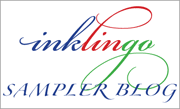So, all blocks have been stitched, and it's time to put it all together, and get your top ready for quilting.
The directions on how to cut and measure are a bit involved but I'll try it anyway. The lack of fixed measurements is because you might have used another size hexagon than I did. I used the 0.5" hexies but if you used the o.75", the 1" or one of the even larger sizes, fixed measurements will be wildly off.
To make this easier to do for yourself, copy the directions, but instead of the words in parentheses, write the actual measurements you arrive at, measurements that are consistent with the size of hexagon you chose to use.
Cut two strips of fabric which is (height of letter block) x (two hexagons width + 0.5")
Join one to each side of your filler-blocks.
Join the blocks into rows, making sure, on the last row, that the strip on the side of your filler-block goes towards the letters, making an extra space between letters and fillers.
(Picture above is a mock-up and the rows are not yet joined on it)
Measure the longest row; that's the TUVW row
Measure the shortest row; that's the KLMN row
Divide the difference in length with two
To the width arrived at, add (two widths of your hexagon + o.5" seam-allowance)
Add a strip (height of letter block) x (the above measurement) to each side of each row.
Yes. You will waste some fabric, but this is the fastest way to do it.
If you don't want to waste any fabric, measure carefully and add strips to either side of each row, according to your measurements.
Find the centre on each strip (folding in half is great)
Join the strips, so that the centre of one row matches the centre of the next row.
Since I have made the letters individually, it is a bear (downright impossible) to press half-way decently in the joins between blocks and in the joins between rows.
I pressed to either side to ease the bulk of the 'bad' joins.
Trim the sides. I aimed at having 1" (= one width of hexagon) on the side of the blocks on the longest row (TUVW)
I then added the same width of Background-fabric border to the top and the bottom, giving a (fairly) uniform space all around the letters. And finally, a wider border, made with my focus-fabric, all the way around.
Layer, baste, quilt-as-desired, bind AND (and this is important) SIGN the quilt. You never know which quilt will end up becoming a family heir-loom, so sign every one of them :-)
Sunday, February 12, 2012
Subscribe to:
Posts (Atom)





